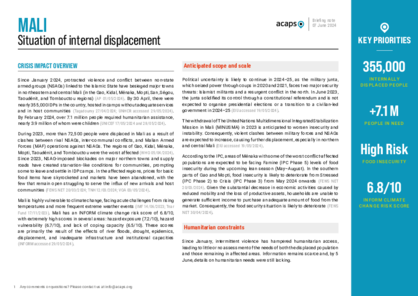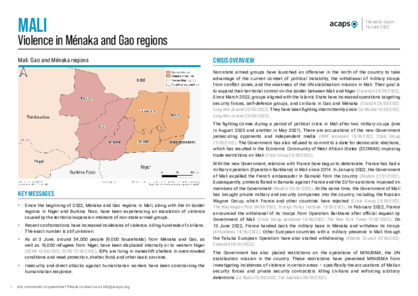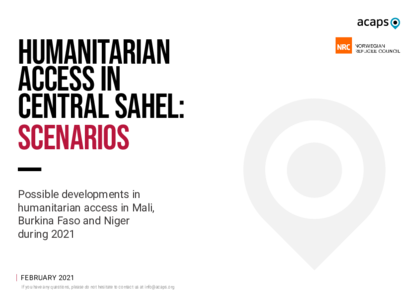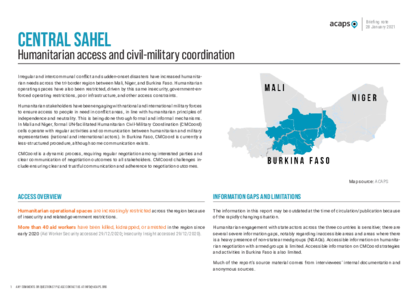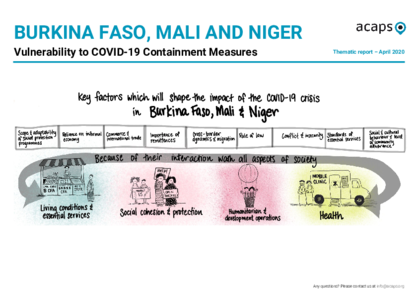Latest updates on country situation
20 January 2025
Gao region in northern Mali continues to face severe flooding caused by the rising waters of the Niger River. Thousands have been displaced and their homes damaged or destroyed. By 17 January, some areas remained isolated, disrupting markets and vital infrastructure. Many residents lack shelter and rely on relatives for refuge. Urgent needs include food, shelter, and healthcare services.
(DW 17/01/2025, Studio Tamani 13/01/2025, Mali Actu 15/01/2025)
15 October 2024
Since April 2024, Mali has been experiencing exceptional rainfall, the heaviest since 1967. The impact has killed at least 76 people, injured 148, and affected around 257,000. Flooding across the country has also postponed the start of the academic year, originally scheduled for 1 October, to 4 November, delaying school for around 3.8 million students. The floods have damaged or destroyed nearly 400 schools, while others serve as shelter for affected people. By 3 October, the most severely affected regions were Gao Mopti, Ségou, and Tombouctou. By May, close to 2,000 schools across the country were already nonfunctional, 91% of which were because of insecurity. These school closures already affected around 588,600 children across the country. The recent damage to education facilities raises fears of a further delayed return to school, increasing the risk of dropouts. The flooding is expected to continue until November. (OCHA 03/10/2024, RFI 09/10/2024, Education Cluster 31/05/2024)
10 September 2024
Flood events across the country since early August, especially in Bamako, Gao, Koulikoro, and Ségou, have led the Malian Government to declare a national state of disaster. By 6 September, the floods had killed 55 people, injured 112, and displaced 73,778. Many of the displaced have sought shelter in schools, risking a delay to the school term planned to start in October. The affected people lack access to food, shelter, and medical care. (STC 06/09/2024, RFI 05/09/2024)
06 August 2024
On 22 and 25 July 2024, heavy rains caused flooding in Bla city and 17 surrounding municipalities of Ségou region. The flood affected over 9,700 people (876 households), 67% of whom were women and children. The rain also destroyed 1,930 houses and damaged another 1,500, 440 latrines, 330 wells, the reference health centre, and technical service offices. At the same time, the flooding led to the loss of 94 tons of cereals, 100 tons of fertiliser, and 4,000 litres of pesticide and herbicide. The authorities and humanitarian responders have provided initial support to the people affected, who need assistance in the form of shelter, emergency latrines, and protection services. (Govt. Mali 01/08/2024, Educo 01/08/2024, OCHA 02/08/2024)
23 July 2024
On 21 July 2024, presumed members of Jama'at Nasr al-Islam wal Muslimin (JNIM) attacked Dembo village in Dimbal municipality (central Mali), killing around 25 people. The majority of the victims were civilians, apart from four Dozos hunters fighting against the armed groups. The JNIM members also looted neighbouring Sogou Dorkoum village. Previously, from 16–19 July, the villages of Bagourou, Deguessagou, and Yabatalou already faced looting. Civilians are facing protection issues in the region, as the JNIM members have made agreements with some localities and often attack those who do not follow their rules. (ECHO 23/07/2024, RFI 22/07/2024)
04 June 2024
In Mali, the security situation remains a significant concern, especially in Ménaka and Kidal, where armed violence has affected agropastoral and commercial activities and displaced people. Insecurity increases the need for humanitarian assistance, as the current Emergency (IPC Phase 4) food insecurity situation in Ménaka is likely to last until September 2024. Although the blockades are no longer as stringent, armed groups continue to impose taxes on vehicles supplying the area, limiting access to some zones and leaving a few households facing Catastrophe (IPC Phase 5) food insecurity. The country has over seven million people in need, 350,000 IDPs, and 90,000 refugees, with 65,000 arrivals since the beginning of the year. (FEWS NET 31/05/2024, RFI 04/06/2024, OCHA 31/05/2024)
23 April 2024
On 16 April, about 110 civilians were kidnapped by members of the Jama'at Nusrat al-Islam wal-Muslimin (Support Group for Islam and Muslims) between Bandiagara and Bankass in the region of Mopti, central Mali. Protection incidents are increasing throughout the country, with more civilians being targeted. A 500% increase in the number of incidents was reported in January 2024 compared to January 2023. Protection is one of the main areas of concern, with about 1.6 million people in need of assistance in Mali. Mopti is among the regions where the severity of needs is highest. (RFI 22/04/2024, ECHO 23/04/2024, Humanitarian Action accessed 25/04/2024)
current crises
in
Mali
These crises have been identified through the INFORM Severity Index, a tool for measuring and comparing the severity of humanitarian crises globally.
MLI001 - Complex crisis
Last updated 28/02/2025
Drivers
Conflict
Displacement
Crisis level
Country
Severity level
4.3 Very High
Access constraints
4.0
Analysis products
on
Mali
07 June 2024
Mali: Situation of internal displacement
DOCUMENT / PDF / 527 KB
Since January 2024, protracted violence and conflict between non-state armed groups (NSAGs) linked to the Islamic State have besieged major towns in northeastern and central Mali (in the Gao, Kidal, Ménaka, Mopti, San, Ségou, Taoudénit, and Tombouctou regions)
Attached resources
16 June 2022
Mali: Violence in Ménaka and Gao regions
DOCUMENT / PDF / 350 KB
Non-state armed groups have launched an offensive in the north of the country to take advantage of the current context of political instability, the withdrawal of military troops from conflict zones, and the weakness of the UN stabilisation mission in Mali. Their goal is to expand their territorial control on the border between Mali and Niger.
31 March 2021
Scenarios: Humanitarian access in Central Sahel
DOCUMENT / PDF / 1 MB
Possible developments in humanitarian access in Mali, Burkina Faso and Niger during 2021.
Attached resources
28 January 2021
Central Sahel: Humanitarian access and civil-military coordination
DOCUMENT / PDF / 924 KB
Irregular and intercommunal conflict and sudden-onset disasters have increased humanitarian needs across the triborder region between Mali, Niger, and Burkina Faso. Humanitarian operating spaces have also been restricted.
29 April 2020
Burkina Faso, Mali and Niger: Vulnerability to COVID-19 containment measures
DOCUMENT / PDF / 1 MB
This report highlights the potential impact of COVID-19 containment measures in three countries in the Sahel region: Burkina Faso, Mali, and Niger. The premise of this regional analysis is that, given these key factors, the three countries are particularly vulnerable to COVID-19 containment measures.


